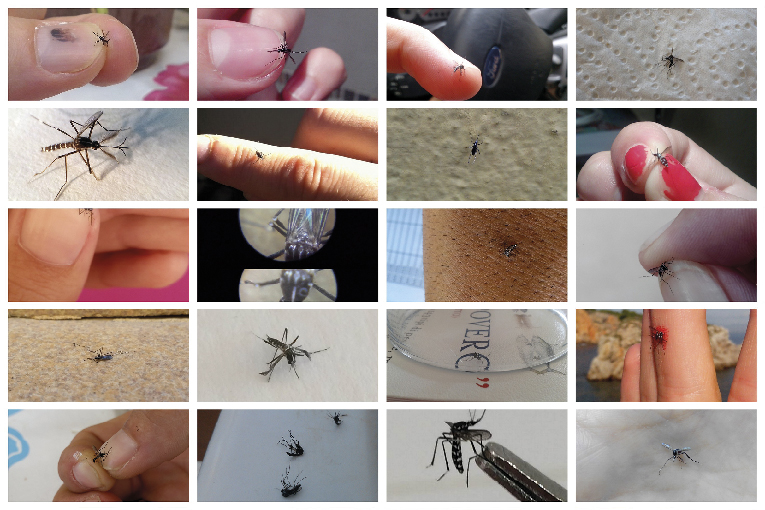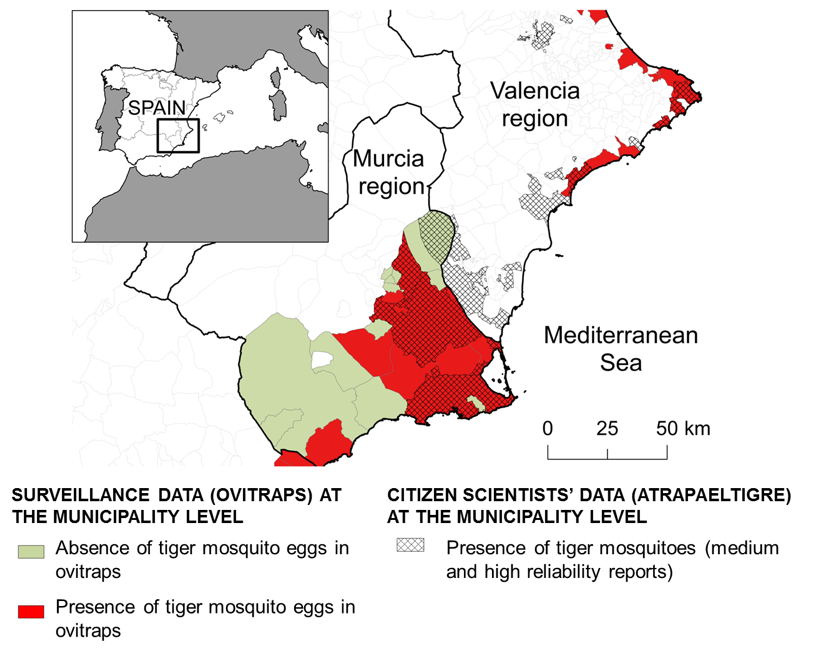
We have created a globalized society, but it is not only human populations that are increasingly interconnected. The movement of invasive species and disease vectors along our expanding routes of trade and migration presents us with serious problems of environmental change and novel public health threats (Crowl, Crist, Parmenter, Belovsky, & Lugo, 2008; Lounibos et al., 2002). This trend can be seen clearly in the case of the Asian tiger mosquito (Aedes albopictus) (Delacour-Estrella et al., 2015), an invasive species from Southeast Asia that has spread worldwide (Hawley et al., 1988) and become common in southern Europe (European Centre for Disease prevention and Control [ECDC], 2015). The tiger mosquito is well known for biting aggressively during the day, and importantly, it is a vector of numerous diseases, including dengue and chikungunya (Paupy, Delatte, Bagny, Corbel, & Fontenille, 2009). It was first detected in Spain in 2004 (Aranda, Eritja, & Roiz, 2006) and is now established along the Spanish Mediterranean coast (Alarcón-Elbal et al., 2014), where it threatens public health and degrades the quality of life, while also harming the tourism sector, which peaks in the summer, just when the species is most active.
The efficacy of public management programs (regional or country scale) for the surveillance and control of tiger mosquitoes is limited. Tiger mosquitoes are known to breed in very small water containers that are plentiful in urban landscapes. These small water containers are not only present in public spaces (fountains, water-drainers) but also in private areas, such as the plates people place under their flower pots on balconies and patios. These management challenges are compounded by the constant importation of mosquitoes from other areas (long-range transport of goods by ship or plane) and their constant redistribution with established ranges in association with private vehicle movement and other routine human mobility patterns (e.g. home-work daily commuting, first-second residence weekend mobility, local-transport of goods). All of this creates a highly complex problem. It is extremely difficult for public health stakeholders to minimize epidemiological risks, the costs of control and surveillance programs easily balloon out of control. In France, for example, the fight against tiger mosquitoes has a cost of 4.5 million euros per year, making them the most costly invasive species in the country (Commissariat général au développement durable, 2015).
‘AtrapaelTigre’: a new source of information
The particularities of the tiger mosquito, with its widespread mobility and plentiful breeding sites, together with the ease with which it can be identified, clearly justifies the exploitation of an IT-based citizen science approach for research, surveillance and control. This is the main motivation of the citizen science project AtrapaelTigre (www.atrapaeltigre.com) implemented in Spain.
The project focuses on: 1) exploring new public participation methodologies for acquiring data for tiger mosquito research, surveillance and control; and 2) raising public awareness and promoting household control actions. The project was initiated in 2013 as a pilot in the province of Girona, and it was extended in 2014 to cover the entire territory of Spain.
In AtrapaelTigre, data collection is done using the smartphone app Tigatrapp, available for Android and iOS on Google Play and1. Tigatrapp enables anyone with a smartphone to participate in scientific research, surveillance, and control of tiger mosquitoes. Since 2014, over 17,000 people have registered as participants, and we have maintained approximately 2,000-3,000 active participants at any given time during the mosquito season, which runs from June to November (Figure 1).
Figure 1. Data collection with Tigatrapp. Citizen scientists’ reports are validated by a network of experts and published in a public webmap. The project website has accumulated about 19,000 visits per month during the peak season of the mosquito in 2015. / AtrapaelTigre.com
The app is linked directly to an interactive webmap at AtrapaelTigre.com, proving real-time data visualization and alerts. Basic information to identify the tiger mosquito (including taxonomy and life cycle) is provided in the app and in the project website. We also hold workshops and talks for specialists and the general public throughout the mosquito season.
With Tigatrapp, anonymous individuals can collect and send geolocalized reports of tiger mosquitoes and their breeding sites providing the following information: 1) location of the observation, obtained by the app directly from the device’s GPS receiver or its network connections or from the participant selecting the location on a map, 2) key taxonomic traits of the reported mosquito or characteristics of the reported breeding site based on a small survey (i.e. user level validation), 3) photographs (compulsory for breeding sites but optional for adult mosquitoes, which are often hard to photograph), and 4) optional complementary notes.
The app also samples anonymized participant locations five times per day (at random times), although participants have the option to opt out of this feature. This background location system is used to estimate sampling effort at a broad scale (Figure 2) which is needed for modelling tiger mosquito presence/absence and learning about human-mediated mosquito transport (e.g. car fluxes). To protect privacy, all background location information is masked on participants’ devices and only the identifiers of the 0.05 degree latitude-longitude grid cells into which locations fall are transmitted to the server. In addition, these locations are identified only by a code that is randomly assigned on the participant’s device, without any additional information or any way to link the location to a given participant’s reports.
Finally, the app (currently only the Android version) incorporates the possibility of special «missions»: specific and voluntary surveys and tasks that reach the phone with a notification. In 2015, several missions were sent in questionnaire format to assess the extent (in terms of probability) to which adult tiger mosquitoes are dispersed in Spain by motor vehicles. There have been more than 1,500 responses and we are currently analysing the results.
In AtrapaelTigre we are currently exploring several methods to validate the incoming reports (both adult tiger mosquitoes and breeding sites) and visualize them in real-time on the web map. We use a three-level validation system that combines app-user validation with crowd and expert validation (Figure 3). App-user validation is based on the participant’s responses to the survey contained in each submitted report. Crowd validation is based on the classification of report pictures by volunteers on the platform Crowdcrafting.org (Tigafotos project). Expert validation consists of the systematic classification of reports, based on their attached photographs, by a team of entomologists. The expert classification is used as the main filtering method in the public webmap, but crowd (if available) and app-user validation results are also displayed. Reports without photographs are displayed as «unclassified».
We use social media (Twitter and Facebook) and the project blog to systematically train and encourage users to take more and better photographs. Due to these efforts, from 2014 to 2015, we have almost tripled the percentage of photographs classified as very probable tiger mosquitoes. In the future we may add the possibility of taxonomical determination of georeferenced mosquito specimens sent by post (Kampen et al., 2015). The ultimate goal would always be to compare the results of several independent validation methods, along with semi-automated and intelligent algorithms based on prior knowledge.
Management and research of tiger mosquitoes with citizen science
Tiger mosquito surveillance and control programs in many European countries rely on ovitrap networks (networks of traps in which females are prone to lay their eggs) that are seasonally and territorially limited by economic budgets and human power. AtrapaelTigre goes beyond these traditional monitoring programs by exploiting new technologies (apps, webmaps, and social media) that enable massive and systematic calls-to-action while making the resulting data immediately available to management services, research institutes, and the general public.
Citizen science as an early warning system and surveillance tool
It is documented that public participation can advance by a few years the detection of invasive species (Scyphers et al., 2014). AtrapaelTigre has already proven itself to be a useful early warning system (the primary role of surveillance). It is a way to first detect the species in regions where its presence is unknown or uncertain due to lack of information. For example, the first-ever report of tiger mosquitoes in Andalusia came from a citizen scientist via Tigatrapp in 2014 (Delacour-Estrella et al., 2014). Similarly, citizen scientists using Tigatrapp were also the first to detect tiger mosquitoes in the Catalan pre-Pyrenees. From its Spanish implementation in 2014, citizen scientists sent reports considered by the expert validators to be probable or highly probable tiger mosquitoes in more than 360 Spanish municipalities. Some of these records constitute the municipality’s first tiger mosquito detections (those from 2015 are yet to be published).
Citizen science systems like AtrapaelTigre are in no way substitutes for specialized active surveillance (e.g. targeted monitoring schedules and sampling methodologies). The detection of the species in the Basque Country in 2014, for instance, came about only through active surveillance (Delacour-Estrella et al., 2015), demonstrating the extent to which the two approaches are complementary. Indeed, efficiency of combining passive (e.g. data gathered by the general public) and active surveillance for mosquitoes in Europe is increasingly apparent (Kampen et al., 2015).
Figure 2 shows how combining AtrapaelTigre data with other sources (such as ovitrap networks placed by public administrations or research departments) can significantly improve our understanding of invasive species and disease vectors. In this example we see how citizen scientiests often report tiger mosquitoes in municipalities that, for any given reason, were not sampled using ovitraps. Conversely, in other areas ovitraps have detected the species while citizen scientists have not. Finally, it is also possible that citizen scientists may correct false negative results from ovitraps. It should be noted that reports from AtrapaelTigre are not used to formally report the discovery of a species in a given area. Rather these reports trigger established protocols whereby specialists collect and store at least one specimen from the area. To this end, we are working together with university departments in charge of tiger mosquito surveillance so that potential new discoveries reported through AtrapaelTigre can be quickly corroborated in the field.
Figure 2. Contribution of citizen science to understanding of tiger mosquito invasion in the vicinity of Murcia and Alicante, Spain, in 2014. The red and grey areas show information about tiger mosquito presence based on traditional ovitrap data, while the hashed areas show information based on citizens scientists’ reports using AtrapaelTigre (probable or highly probable reports after expert validation). The combination of several sources of information is key. Spanish administrative divisions used in the figure were obtained from © Instituto Geográfico Nacional de España and world boundaries from World Continents ESRI. / AtrapaelTigre.com
Citizen science as a management tool
In those areas where the mosquito is established, AtrapaelTigre is useful as a control system. We are currently developing tools (e.g. web-interfaces) to make citizen science data more accessible and useful to actors and stakeholders (e.g. public health agencies) responsible for the epidemiological control of mosquito-borne diseases in large cities. In 2015, we began a pilot project with the Barcelona Municipality’s Public Health Agency (ASPB), through which the agency uses real time citizen information from AtrapaelTigre to complement its control program. The program focuses on: priority tiger mosquito breeding risk areas, phone call incidences, and arbovirus cases (control actions on areas of the city where imported infections exist). To date, around 84% of the adult tiger mosquito and breeding site reports by citizen scientists in Barcelona have been used by the ASPB in one of these focal areas. We are currently assessing the real costs and benefits of this joint pilot. Other large cities like Valencia are also using the platform for real-time control actions. All signs are that this type of involvement is highly beneficial and is proving crucial for the long-term maintenance of the whole participatory system.
Citizen science as a predictive modelling tool
From a scientific perspective, an important challenge for AtrapaelTigre (and, by extension, other citizen science projects) is to demonstrate how the combination of citizens and ovitrap surveillance data (Kampen et al., 2015) can improve predictions of the distribution (current and potential), risk factors, and spreading dynamics of the targeted species. Ovitrap networks are a proven sampling methodology from a technical and scientific perspective but are limited in time and space, whereas citizen science data might be noisy and less reliable but can be massive, covering much broader spatio-temporal scales. The key is to let the strengths of each approach compensate for the other’s weaknesses and to use reliable results from each as a means of cross-calibration. We expect to be able to use both types of data (ovitrap networks and citizens) with novel modelling approaches to produce more robust models of the actual and potential distributions of tiger mosquitoes in Spain, and more relevant, better predictions about the risk of mosquito-borne diseases, such as dengue and chikungunya in Spain. Predictive models combining citizen science and expert surveillance data appear to offer a solid basis for long-term cost-effective management strategies.
The tiger mosquito in Spain: current knowledge and citizen science contribution
Apart from the comparison of citizen science results to ovitrap data, it is important to consider more broadly what we know of the tiger mosquito distribution and how citizen science has contributed to this. Currently, there is no regular and homogenous sampling of tiger mosquitoes for the full territory of Spain. While there is a large amount of information in some zones, there is little in others.
We are just at the beginning of a new era where techncology and Big Data will bridge the communication between citizens and scientists in unexpected ways and with unprecedented levels of detail. There is still a long route to go but we are aware that what we have started has no way back and, more specifically, that the citizens science approach promoted by the AtrapaelTigre, is going to have a key role in controlling this an other vector-borne diseases in a globalised world.
1. Tigatrapp and the entire AtrapaelTigre platform are free and open source software, with all source code available at http://github.com/MoveLab (Go back)
Acknowledgements
AtrapaelTigre.com has been funded by the Spanish Foundation for Science and Technology-Ministry of Economy and Competitiveness (FCT-12-3730, FCT-13-7019), Lokímica and Plan Estatal I+D+I. (CGL2013-43139-R), in collaboration with ”la Caixa” Banking Foundation. The research leading to these results has received also funding from RecerCaixa. We want to thank all of the participants, students, volunteers, and professionals who have made the project possible. We want to acknowledge Dr. Juan Antonio Delgado Iniesta and Dr. Francisco de Asís Collantes from the University of Murcia for providing ovitrap data shown in Figure 4. We also thank all the AtrapelTigre team A. Ramon, M. Torres and J. L. Ordoñez (communication team), as well as R. Eritja, S. Delacour, M. Bengoa and P. Alarcón-Elbal (expert validation team).
References
Alarcón-Elbal, P. M., Delacour-Estrella, S., Ruiz-Arrondo, I., Collantes, F., Delgado, J. A., Morales-Bueno, J., … & Lucientes, J. (2014). Updated distribution of Aedes albopictus (Diptera: Culicidae) in Spain: new findings in the mainland Spanish Levante, 2013. Memórias do Instituto Oswaldo Cruz, 109(6), 782–786. doi: 10.1590/0074-0276140214
Aranda, C., Eritja, R., & Roiz, D. (2006). First record and establishment of the mosquito Aedes albopictus in Spain. Medical and Veterinary Entomology, 20(1), 150–152. doi: 10.1111/j.1365-2915.2006.00605.x
Commissariat général au développement durable. Ministère de l’Écologie du Developpement durable et de l’Énergie. (2015). Analyse économique des espèces exotiques envahissantes en France. Première enquête nationale (2009-2013). Retrieved from http://www.developpement-durable.gouv.fr/Analyse-economique-des-especes.html
Crowl, T. A., Crist, T. O., Parmenter, R. R., Belovsky, G., & Lugo, A. E. (2008). The spread of invasive species and infectious disease as drivers of ecosystem change. Frontiers in Ecology and the Environment, 6(5), 238–246. doi: 10.1890/070151
Delacour-Estrella, S., Collantes, F., Ruiz-Arrondo, I., Alarcón-Elbal, P. M., Delgado, J. A., Eritja, R., … & Lucientes, J. (2014). Primera cita de mosquito tigre, Aedes albopictus (Diptera, Culicidae), para Andalucía y primera corroboración de los datos de la aplicación Tigatrapp. Anales de Biología, 36, 93–96. doi: 10.6018/analesbio.36.16
Delacour-Estrella, S., Barandika, J. F., García-Pérez, A. L., Collantes, F., Ruiz-Arrondo, I., Alarcón-Elbal, … & Lucientes, J. (2015). Detección temprana de mosquito tigre, Aedes albopictus (Skuse, 1894), en el País Vasco (España). Anales de Biología, 37, 25–30. doi: 10.6018/analesbio.37.3
European Centre for Disease Prevention and Control (2015). Mosquito maps: Retrieved from http://ecdc.europa.eu/en/healthtopics/vectors/vector-maps/Pages/VBORNET_maps.aspx.
Hawley, W. A. (1988). The biology of Aedes albopictus. Journal of the American Mosquito Control Association, Supplement, 1, 1–39.
Kampen, H., Medlock, J. M., Vaux, A. G. C., Koenraadt, C. J. M., van Vliet, A. J. H., Bartumeus, F., … & Werner, D. (2015). Approaches to passive mosquito surveillance in the EU. Parasites & Vectors, 8, 9. doi: 10.1186/s13071-014-0604-5.
Lounibos, L. P. (2002). Invasions by insect vectors of human disease. Annual Review of Entomology, 47, 233–266. doi: 10.1146/annurev.ento.47.091201.145206
Paupy, C., Delatte, H., Bagny, L., Corbel, V., & Fontenille D. (2009). Aedes albopictus, an arbovirus vector: from the darkness to the light. Microbes and Infection, 11(14-16), 1177–1185. 10.1016/j.micinf.2009.05.005
Scyphers, S. B., Powers, S. P., Adkins, J. L., Drymon, J. M., Martin, C. W., Schobernd, Z. H., …& Switzer, T. S. (2014). The role of citizens in detecting and responding to a rapid marine invasion. Conservation Letters, 8(4), 242–250. doi: 10.1111/conl.12127







